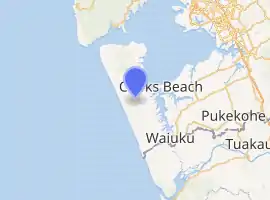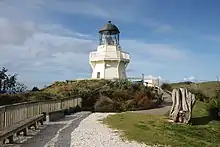Āwhitu Peninsula
The Āwhitu Peninsula is a long peninsula in the North Island of New Zealand, extending north from the mouth of the Waikato River to the entrance to Manukau Harbour.
Āwhitu Peninsula | |
|---|---|

| |
| Coordinates: 37.166°S 174.633°E | |
| Country | New Zealand |
| Region | Auckland Region |
| Ward | Franklin Ward |
| Population (2018) | |
| • Total | 2,919 |
The Peninsula is bounded in the west by rugged cliffs over the Tasman Sea, but it slopes gently to the west, with low-lying pastoral and swamp land along the edge of the Waiuku River and Manukau Harbour. At the northern tip, the Manukau Heads rises to a 285-metre (935 ft) prominence above the entrance to the similarly named harbour. The nearby historic Manukau Heads Lighthouse is one of the few in the country open to the public.[1]
The peninsula is relatively sparsely populated, despite its proximity to the centre of Auckland city (which lies 30 kilometres (19 mi) to the northeast). The largest settlement on or near the peninsula is Waiuku, which lies at the peninsula's isthmus.
Demographics
| Year | Pop. | ±% p.a. |
|---|---|---|
| 2006 | 2,538 | — |
| 2013 | 2,511 | −0.15% |
| 2018 | 2,919 | +3.06% |
| Source: [2] | ||
.jpg.webp)

Āwhitu had a population of 2,919 at the 2018 New Zealand census, an increase of 408 people (16.2%) since the 2013 census, and an increase of 381 people (15.0%) since the 2006 census. There were 1,107 households. There were 1,467 males and 1,452 females, giving a sex ratio of 1.01 males per female. The median age was 47.4 years, with 525 people (18.0%) aged under 15 years, 387 (13.3%) aged 15 to 29, 1,512 (51.8%) aged 30 to 64, and 492 (16.9%) aged 65 or older.
Ethnicities were 89.6% European/Pākehā, 12.8% Māori, 2.8% Pacific peoples, 3.8% Asian, and 1.7% other ethnicities (totals add to more than 100% since people could identify with multiple ethnicities).
The proportion of people born overseas was 17.0%, compared with 27.1% nationally.
Although some people objected to giving their religion, 60.7% had no religion, 26.5% were Christian, and 3.6% had other religions.
Of those at least 15 years old, 312 (13.0%) people had a bachelor or higher degree, and 522 (21.8%) people had no formal qualifications. The median income was $34,700. The employment status of those at least 15 was that 1,236 (51.6%) people were employed full-time, 354 (14.8%) were part-time, and 75 (3.1%) were unemployed.[2]
Education
.jpg.webp)
Awhitu District School and Waipipi School are coeducational full primary schools (years 1-8) with rolls of 103 and 154 students respectively as of March 2020.[3][4][5]
Biodiversity
The Peninsula has a high sympatric diversity of native New Zealand land snails. Communities of >70 native species in a 4 ha patch of bush can be found here, whereas in other parts of the world, 15 sympatric land snail species would be considered high.[6][7] Grazing and other habitat disturbances can negatively impact this diversity.[8]
References
- "Awhitu Peninsula," aucklandnz.com. Retrieved 29 April 2019.
- "Statistical area 1 dataset for 2018 Census". Statistics New Zealand. March 2020. Āwhitu (149900). 2018 Census place summary: Āwhitu
- "New Zealand Schools Directory". New Zealand Ministry of Education. Retrieved 26 April 2020.
- Education Counts: Awhitu District School
- Education Counts: Waipipi School
- Solem, Alan; Climo, Frank M.; Roscoe, David J. (1981). "Sympatric species diversity of New Zealand land snails". New Zealand Journal of Zoology. 8 (4): 453–485. doi:10.1080/03014223.1981.10427971. ISSN 0301-4223.
- Barker, G.M. (2006). "The astonishing diversity of land snails". In Harvey, Bruce James; Harvey, Trixie (eds.). Waitakere Ranges: Ranges of inspiration. Waitakere Ranges Protection Society. pp. 130–139. ISBN 0476005205.
- Bogich, Tiffany L.; Barker, Gary M.; Mahlfeld, Karin; Climo, Frank; Green, Rhys; Balmford, Andrew (2012). "Fragmentation, grazing and the species–area relationship". Ecography. 35 (3): 224–231. doi:10.1111/j.1600-0587.2011.07136.x. ISSN 1600-0587.